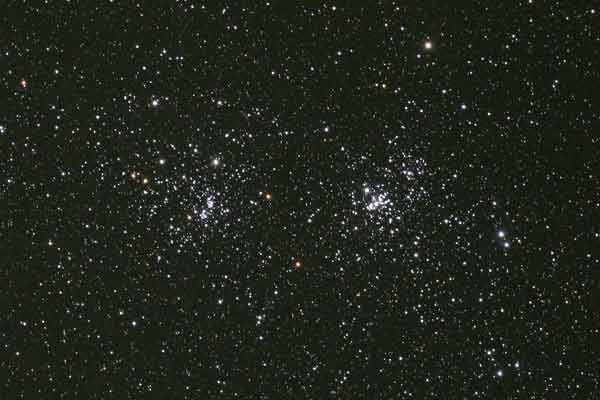The Double Cluster, NGC 869 (right) and NGC 884 (left) with north to the top (*)
NGC 869 is an open cluster located 6800 light years[2] away in the constellation of Perseus. The cluster is most likely around 19[2] million years old. It is the westernmost of the Double Cluster with NGC 884. Located in the Perseus OB1 association both clusters are located physically close to one another, only a few hundred light years apart. The clusters were first recorded by Hipparchus, but have likely been known since antiquity. The Double Cluster is a favorite of amateur astronomers. These bright clusters are often photographed or observed with small telescopes. Easy to find, the clusters are visible with the unaided eye between the constellations of Perseus and Cassiopeia as a brighter patch in the winter Milky Way. In small telescopes the cluster appears as a beautiful assemblage of bright stars located in a rich star field. Dominated by bright blue stars the cluster also hosts a few orange stars that add to the visual interest. Sometimes known as h Per this designation more probably refers to a nearby dim star[3]. Links
References 1. ^ a b c d e f g SIMBAD Astronomical Database. Results for NGC 869. Retrieved on 2006-12-22. 2. ^ a b c d N.V. Kharchenko, A.E. Piskunov, S. Röser, E. Schilbach, and R.-D. Scholz, 2005, "Astrophysical Parameters of Galactic Open Clusters", Astronomy and Astrophysics, Volume 438, Issue 3, August 2005, pp.1163-1173 3. ^ Stephen James O'Meara and Daniel W.E. Green, 2003, "The Mystery of the Double Cluster", Sky and Telescope,Vol. 105, No. 2, p. 116-119 (February 2003)
Retrieved from "http://en.wikipedia.org/"

|
|
||||||||||||||||||||||||||||||||||||
